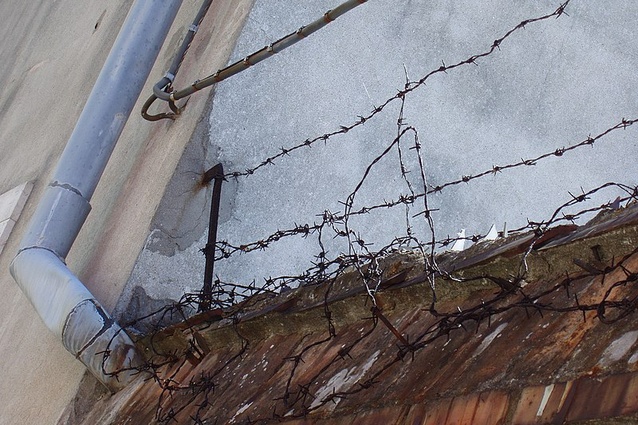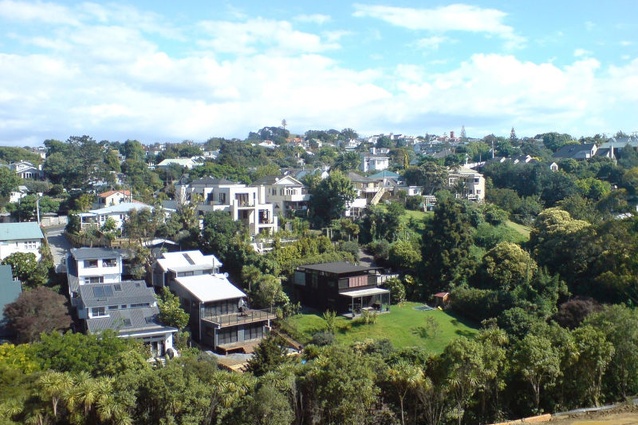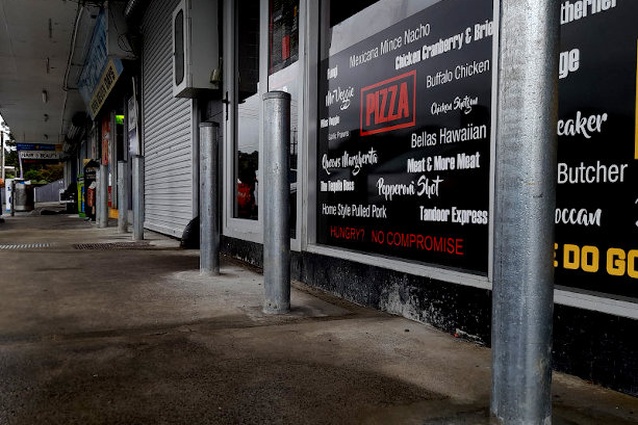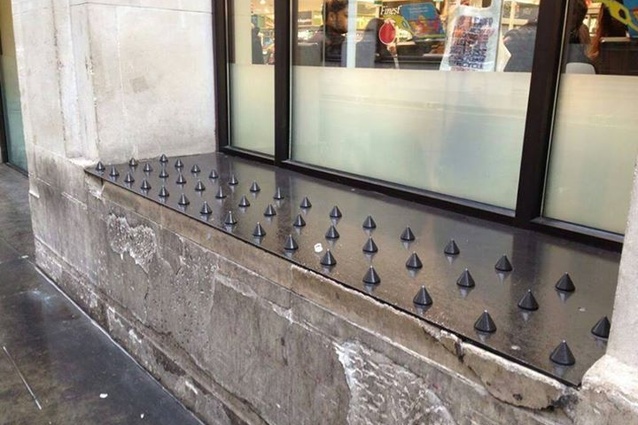Hostile architecture, as seen from the suburbs of an expensive city
Eu Jin Chua points out that the currently fashionable (but nebulous) concept of hostile architecture is not so much about specific objects or specific buildings, but rather about social, political and economic relations.
Hostile architecture is a concept that seems to have gained currency amongst architectural writers some time in the past decade. From what I can tell, it’s the contemporary equivalent of what used to be called defensive architecture, that is, edifices for keeping out the undesirables — for example, the medieval moat and castle wall holding back a barbarian invasion or siege laid on by neighbouring feudal lord. But the new coinage is meant to convey the specific dystopianism of our own times: the walls around the mansions or gated communities of the super-rich, metal spikes that prevent the homeless from sleeping in doorways and alcoves, security cameras that compel the rabble to self-police their behaviour, and underground bunkers for billionaires to escape the apocalypse.1 Like the moat and castle wall in their time, these concrete phenomena of our time are examples of the way in which underlying structures of economy and social contract take on tangible form. Can it be a surprise that when society is run in accordance with economic principles that produce enormous disparities in wealth and opportunity, that unnecessarily create an underclass, it will follow that our cities begin to feature defensive elements intended to keep away the new undesirables so defined?
Yet when an art gallery in Auckland commissioned me, over a year ago, to write a piece about hostile architecture,2 I wondered what on earth this had to do with my suburban existence in Aotearoa. My uncertainty about what to say arose from an initial sense that New Zealand is hardly a global hotspot for this phenomenon. A quick scan of the literature confirms that people started using the term “hostile architecture” (or “hostile design”) in connection with heavily urbanised places. Before I lived in New Zealand, I lived in some of these other places, including cities where much was chaos, crime was severe, and it was normal for the middle and upper classes to barricade windows with metal bars and erect barbed fences around their homes to avoid midnight robbery at gunpoint. (Those who hate oppression can still have good cause to fear the oppressed, as per V.S. Naipaul.) In comparison with this, it seemed a joke to claim that “hostile architecture” is a pressing problem in famously tranquil New Zealand. Thus was I stumped as I sat pretty in a room of my own in suburban Auckland during the height of the Covid pandemic — surrounded by a hedge, a fence, a gate, a great deal of unearned good fortune and privilege, and one of the most stringent cordons sanitaires anywhere in the world for keeping out the pestilentials.
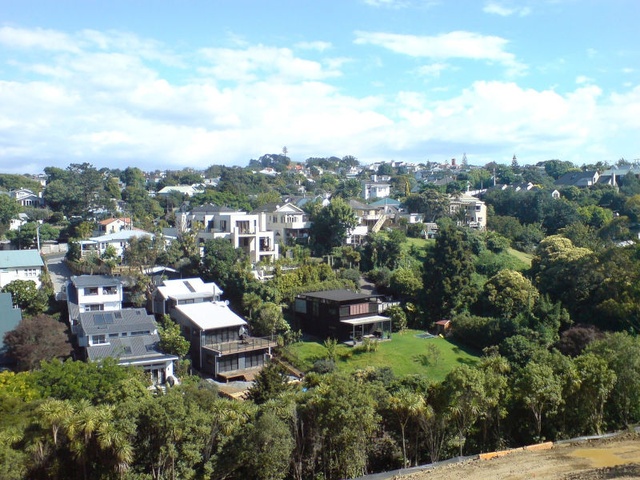
This may be a case where we apply the rule that many conceptual descriptors originating in the Euro-American metropoles require adaptation when imported into urban environments of a different character. Relative to many places elsewhere, the primary spatial or architectural experience in New Zealand is still suburban or rural. Even the most central suburbs of New Zealand’s largest cities tend to resemble country villages or Levittowns when compared to the nature of other urban centres around the globe. (In Auckland: endless motorways leading to endless leafy residential enclaves, and, until recently, scant provision for pedestrians, bikes, and public transport.) Thus “hostile architecture” is a term requiring suburban modifications when plonked into the middle of middle New Zealand.
What is ‘hostile architecture’ in a city that has been planned to be primarily suburban, sprawling and NIMBYist? If you’re on foot and can’t afford a car, the answer is: just about everything. In the suburbs, there’s no need for metal spikes to keep away the homeless when the homeless are already bedevilled by uncrossable highways and barren strip malls. Likewise the hedge, the fence, the gate, are the hostile architecture in the suburbs, buttressed by equally hostile yet more intangible things like the entrenched laws of private property, the economic levers that favour private investment over the public good of secure housing, and the unconscious biases that make the middle- and upper-classes whiter than the average. The local story of hostile architecture in Tāmaki Makaurau — a city whose housing market was calculated to be the seventh most unaffordable in the world in 2023 — inevitably turns out to be a story about private property, urban sprawl, the crisis of housing affordability, and the legacies of colonialism.3
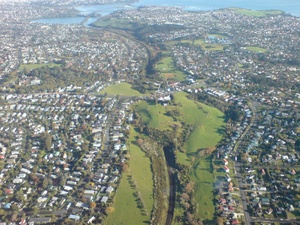
‘Hostile architecture’ is really just a new way of describing an old fact, namely that the built environments of our everyday lives are servants of the status quo, mostly because infrastructure costs a lot of money and can only come into being from out of a prevailing dispensation. Social contracts, written or unwritten, influence our ways of life, and our buildings, deliberately or inadvertently, will propagate and enforce the norms. (Or resist them – but resistance to a norm is equally a response to the baseline of the normal or, as philosophers say, the “normative”.)
But if the underlying social contract changes, the “normal” use of objects can likewise change. This is to say that hostile architecture is a concept plagued by relativity; its apparent trendiness hides the fact that it falls to pieces when examined too closely. For the term gets very hazy when we realize that any architecture or built form can be deemed “hostile” depending on who is doing the talking and what social or economic configuration we’re talking about.4 Hostile architecture is not a thing but a social relation. Any form of architecture, any corner of the city, can be a cudgel depending on who uses it and for what social purpose, on where you stand in the socioeconomic strata, on how the social order shakes out. Those who try to definitively distinguish hostile architecture from not-hostile architecture — things that look like bunkers versus things that don’t look like bunkers! — run the risk of being sophomorically categorical, run the risk of demonstrating how architectural thinking often relies on cut-and-dried object-categories rather than acknowledging the shifting intangibles of the social and the political.
Indeed anyone who is securely housed in any leafy suburb of any city blighted by rampant inequality could, nowadays, be considered a perpetrator of “hostile architecture”, a conscripted belligerent in the war of rentiers against renters, homeowners against the housing precariat. This is not mainly a matter of personal culpability nor supposedly “hostile” features of buildings, but a matter of the zero-sum game of failed trickle-down economics. In our currently dysfunctional social contract, ordinary homes and middle-class stabilities become acts of hostility against those who have been shut out of them by decades of misguided, imbalanced, and self-destructive economic policies.5
Think about climate change too. In the absence of renewable energy, heating or cooling one’s house over a bourgeois lifetime is the equivalent of killing one or more people in less developed parts of the world. Everyone’s house can be deadly to someone else, owing to decades of environmental policies warped by free-market fundamentalism.6
I wrote much of the above during pandemic lockdowns, before housing markets everywhere started to cool, before civil conflict on parliament grounds, before Cyclone Gabrielle really gave us a taster of our future lives in the age of climate change — before the general election cycle rolled back round. Sure enough, when circumstances change, the examples of hostile architecture change. Ramraids and anti-ramraid bollards are now the equivalent of siege warfare in Kiwi cities. “Defensive architecture” now means something different when the goal is to barricade against floods and cyclones.7 And when AI is running our homes in ten years’ time, will hostile architecture be person or machine, animal, vegetable, or mineral? (Clue: none of the above, it will still be a social relation!)

All that floodwater in January and February tells us another thing about hostile architecture: these days, it’s a circular social relation. We’re our own worst enemies, and we build ramparts against our own Frankensteinian creations. What goes around comes around: the carbon spewing from your house comes back in the form of the wading pool you used to call your kitchen. The kid that your libertarianly low property taxes failed to educate will return to rob your house. Build the walls higher.
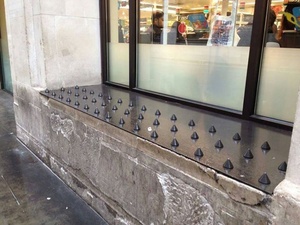
As the world gets hotter and more dysfunctional, the concept of hostile architecture gets less and less useful because it’s more and more generalisable. What’s hostile architecture? Yes! When the political-economic edifices of human society are set up imprudently, everything is hostile, even the sun and the rain. When things go bad within the misguided logic of a zero-sum game, all buildings become weaponised, all occupants occupiers, and onward we slide into uncertain dystopia.
1 The term seems to have gained popularity in connection with a controversy about anti-homeless spikes in London. See Josh Halliday, “Council urged to act over ‘inhumane’ use of spikes to deter homeless”, The Guardian, June 8, 2014, https://www.theguardian.com/society/2014/jun/08/metal-spikes-london-flats-homeless. The New York Times has reported on hostile architecture (https://www.nytimes.com/2019/11/08/nyregion/hostile-architecture-nyc.html) and Wikipedia now features a lengthy entry on the subject. Here is a partial reading list on“hostile architecture” and “hostile design”: James Petty, “The London Spikes Controversy: Homelessness, Urban Securitisation and the Question of ‘Hostile Architecture,’” International Journal for Crime, Justice and Social Democracy 5, no. 1 (2016): 67–81; Naomi Smith and Peter Walters, “Desire Lines and Defensive Architecture in Modern Urban Environments.” Urban Studies 55, no. 13 (2018): 2980–95; Aubrey Bader, ”Hostile Architecture: Our Past, Present, & Future?” Crit 86 (Jan 2020): 48-51;and Robert Rosenberger, “On Hostile Design: Theoretical and Empirical Prospects,” Urban Studies 57, no. 4 (2020): 883–93.
2 This was in connection to an exhibition whose theme eventually morphed into something different (https://www.objectspace.org.nz/exhibitions/toro-whakaara-responses-to-our-built-environment/). Thanks to Isobel Thom, Tessa Forde, Zoe Black, and Kim Paton for the original commission that led to this present offshoot piece. Isaac Sweetapple’s review of the eventual exhibition is in the March/April 2022 issue of Architecture NZ.
3 I wrote this article in a privately owned house built on unceded land historically associated with several Māori iwi, notably Te Kawerau ā Maki.
4 Rosenberger, “On Hostile Design”, 889.
5 See the essays in Inequality: A New Zealand Crisis, edited by Max Rashbrooke (Auckland: Bridget Williams Books, 2013). And https://www.rnz.co.nz/national/programmes/afternoons/audio/2018820585/max-rashbrooke-s-latest-book-on-wealth-disparity-in-aotearoa
6 Naomi Oreskes and Eric M. Conway, “Market Failure”, The Collapse of Western Civilization (New York: Columbia University Press, 2014), 35-49.
7 Chris Barton, “After the Floods”, Architecture NZ, March/April 2023, pp. 16, 18.

